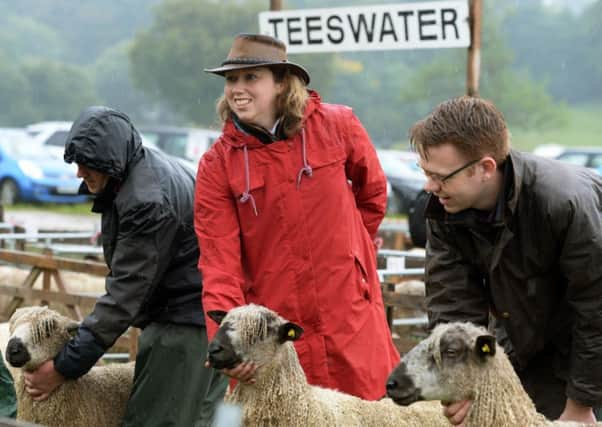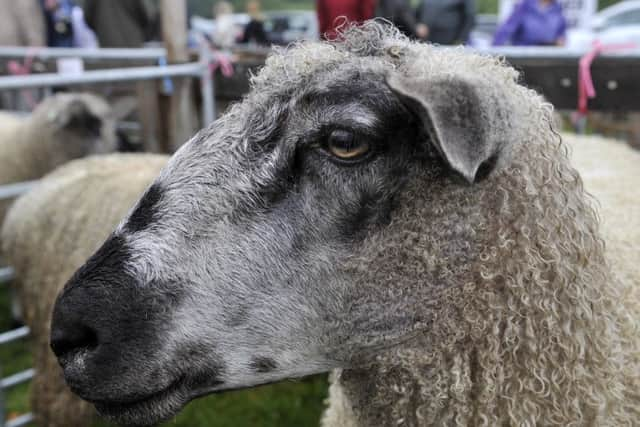Teeswaters are part of the family in Stainburn


One sheep breed had seemingly lost its own local spat a century ago when it was close to being wiped out by a near neighbour but the work of a few breeders brought it back into focus and saw its return as a favoured sire of horned ewes.
Ask anyone who knows anything about Teeswater sheep and the initials JB won’t be far away from being mentioned in connection with the advancement of the breed around that time. JB Liddle farmed at Paddock Hall Farm, Stainburn near Otley and it was he and his son, Keith, who were in the vanguard of the drive of the Teeswater to regain the territory it had lost to the Wensleydale.
Advertisement
Hide AdAdvertisement
Hide AdThe late Bert Verity of Kirkby Overblow noted that breeders Thomas Addison and JB Liddle decided to try and breed a Teeswater Ram that bred only black and white faced lambs. When this was achieved Bert did not know but he assumed it was sometime between 1935 and 1945 to allow for the spread of the breed to 185 members by 1949.


It was the emergence of black and white lambs that brought about the spread of the Teeswater breed and the decline of the Wensleydale.
Today the family connection continues with JB’s great granddaughter Christina Liddle as secretary of the Teeswater Sheep Breeders Association. Christina is gearing up for this year’s annual show and sale of Teeswater sheep to be held at Leyburn livestock market next Thursday, October 5.
Christina lives with her parents John and Susan at Home Farm, Stainburn where they have a small flock of Teeswaters among their much larger flock of breeding ewes made up of Mashams, Dalesbreds, Masham X Texels and Lonks.
Advertisement
Hide AdAdvertisement
Hide Ad“My great grandfather JB and my granddad Keith were both well known for their commitment to the Teeswater breed. I worked at Betty’s over Christmas last year and one lady who saw my surname asked if I was any relation to JB. It was great granddad who had started with them and helped build back the breed’s popularity in being the number one sire for use on many horned ewes in the north of England.


“Teeswaters have a fabulous reputation as long life, big, strong sheep that are very lean. They are bred for use primarily as a sire for the Masham and the ewes are extremely prolific. They are great mothers who will rear on average at least two lambs a year. We lambed 14 at Home Farm in April this year and had two lambs from ten of them, three had three and just one had a single.
“The show and sale at Leyburn is the breed’s prime sale of the year, with two others held at Bentham and Melton Mowbray. We’ve 158 sheep entered for next Thursday from 23 vendors including many well known names in the breed from the Bainbridge Brothers of Marrick Abbey to Andrew Fisher of Summerbridge and Charles Marwood of Whenby.”
The Teeswater started from the Tees Valley around 200 years ago but had become rare by the 1920s following a move toward the Wensleydale. It had a renaissance after the Second World War at the time when JB Liddle had been one of those leading the way particularly in producing the Masham through crossing the Teeswater ram on to the Dalesbred ewe. Popularity of the Masham declined in favour of the Mule in the past 30 years, but the Teeswater remains a go-to sire for horned ewes such as the Swaledale, Rough Fell and Scotch Blackface.
Advertisement
Hide AdAdvertisement
Hide Ad“Teeswater Sheep Breeders Association was formed in 1949,” says Christina. ‘The main aims are to encourage breeders, improve the breeding of Teeswaters and to maintain their purity and supremacy as a sire for use on the horned ewe. They’ve always done very well for us and produce an excellent Masham.
“Three of our four Masham show lambs were by one Teeswater tup so he will tup the majority of our Teeswater ewes this year. We don’t use our own Teeswater rams back on to the Teeswater ewes until they have proved themselves with the quality of Mashams they have produced.”
The Liddles concentrate their own agricultural show participation on the Mashams, but with Christina’s breed hat on she is always keen to see the Teeswaters’ progress through others. Recently that has also included a revival in the demand for fleeces.
“The Teeswater has always been seen as a hardy breed and offering great longevity that breeders are looking for in their progeny, but where we’ve also seen a greater interest over the past few years is in the number of spinners seeking out both Teeswater and Masham fleeces. People like the provenance of native breeds and the long, fine staple that the Teeswater offers.”
FLOCK OF AGES
Advertisement
Hide AdAdvertisement
Hide AdThursday’s Teeswater show and sale will include sheep from breeders in Northern Ireland, Cumbria, Lancashire and Yorkshire.
Judging starts at 10.30am with the sale set to commence at 12.30pm. Teeswater ewes can produce lambs at up to 10-12 years old and their prolificacy can see them record flock averages of up to 250 per cent. Teeswater lamb is also renowned for its leanness.
Staple length of the Teeswater is between 20-30 cms and each lock should hang freely. Teeswater wool is used in the production of worsted suits and for knitting wool.